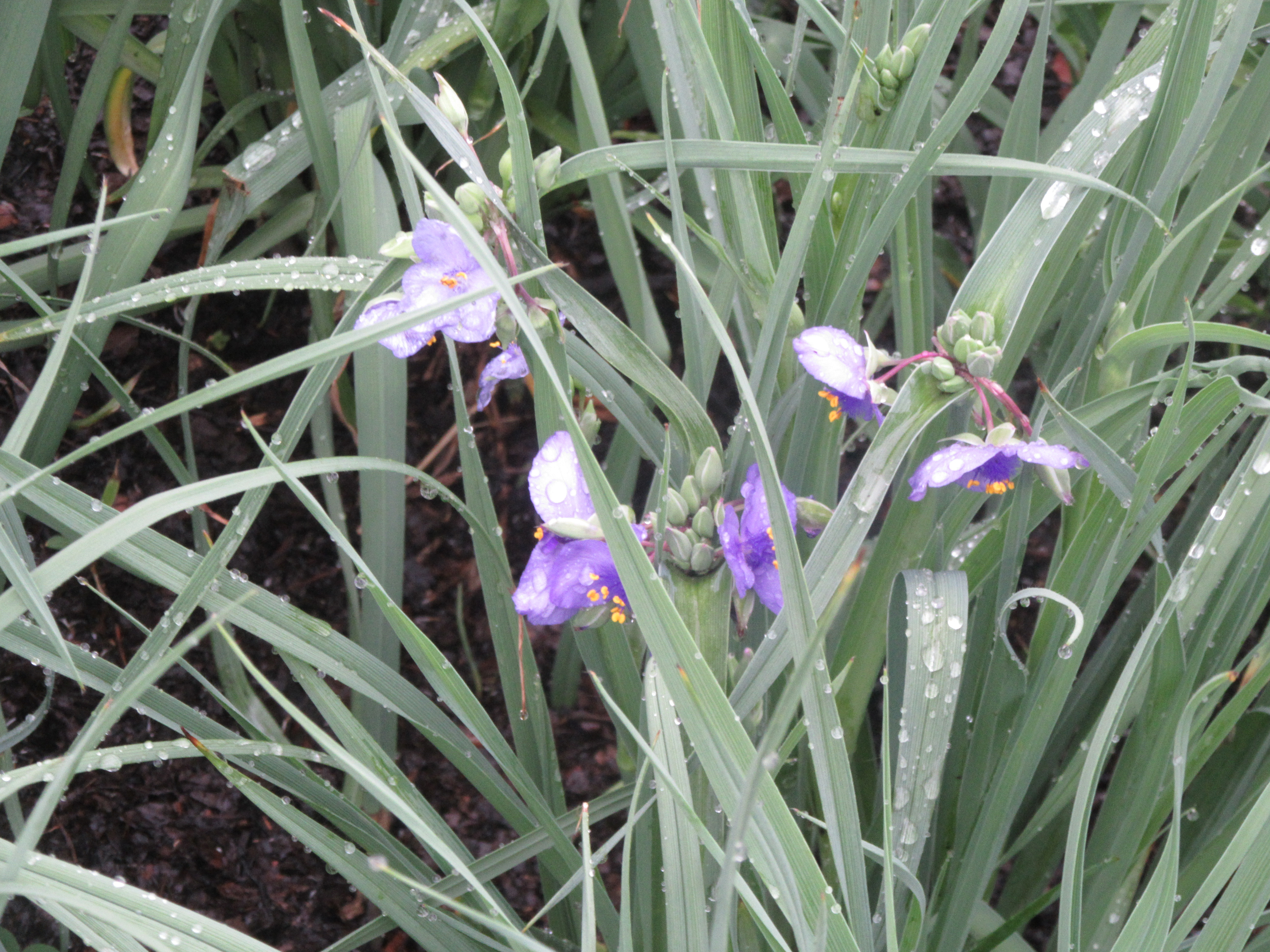May 4 was a cool, drippy day, but the plants were very happy, as 90 or so locals studied them on the Mount Vernon Governmental Center grounds.
Part of what was formerly grassy lawn is transitioning into beds of vibrant habitat that support native insects, birds and other wildlife, thanks to Supervisor Dan Storck. He explained, “When I first took office, I noticed the barren, unattractive and uninviting lawn that surrounded the Governmental Center and reached out and worked with our local flora and fauna advocates to change it. Creating native gardens to support our native birds and insects is an important environmental initiative as we continue to see loss of habitat,

Many plants like spiderwort were thriving in the drizzly weather.
How It Happened
Cathy Ledec, former Fairfax County Tree Commission Chair, led the effort, starting in 2018. Now living in Massachusetts, Cathy and her husband, George, returned on Saturday for the walkaround. “It’s much better than I expected,” she commented. She had assumed the ground was dry, but the roof’s runoff supplies more water to some of the sites than she anticipated.
Pointing to a serviceberry shrub, she said, “I wanted Dan and the staff to have something to look at instead of asphalt.”
Referring to his staff, Supervisor Stock concurred, “TEAM MVD enjoys looking out our windows at perennials specifically chosen for year-round blooming that also provide an inviting public space for residents to enjoy.”
Volunteers also planted 12 trees which can help shade and cool the building in the summer, thus reducing energy costs.
Suzanne Foster, a county landscape architect, led three tours of five beds and two stormwater bioretention facilities. Stantec designed the beds, planted with “large sweeps of one species,” Foster explained, plants like spiderwort, golden ragwort, green and gold, deer tongue, white wood aster, Christmas fern and black-eyed Susans. Some naturally spread and when they do, they can crowd out invasives and reduce maintenance.
People should expect failure when doing planting projects, Foster advised, and maintenance is key the first year. It usually takes several years for plants to get established, she said, recommending leaf mulch, not woodchips, which can smother plants.
The county retrofitted two stormwater facilities that collect runoff from the Governmental Center, fire station, Sherwood Regional Library, three parking lots and adjoining streets. There contractors planted, for example, sweet bay magnolias, Joe Pye weed, common milkweed and goldenrod. Prior to the retrofits, workers mowed four times a year. Now they mow only the perimeter once a year.
Mount Vernonite Deborah Matthews commented, “This is an excellent demonstration of what we can do with native plants. It’s a public resource.”
Why Natives?
Matt Bright, Executive Director of Earth Sangha, a Springfield native plant nursery and supplier of the plants, explained, “Native plants are the foundation for how the ecosystem functions for wildlife and the food chain. It helps restore the soil. We can begin to restore the system, especially suburban lots which could have ecotones for insects and other wildlife.” Unlike most invasive plants, native plants support the native insects with which they co-evolved.
County Policy
In 2020, the Board of Supervisors adopted Supervisor Storck’s amendment to Fairfax County’s comprehensive plan to apply natural landscaping to county properties. Natural landscaping largely minimizes lawns and uses native plants to restore natural ecological functions.
Other project supporters include Audubon at Home, Boy Scouts, Fairfax Master Naturalists, the Northern Virginia Soil and Water Conservation District.
More information
https://www.fairfaxcounty.gov/mountvernon/mount-vernon-governmental-center-native-perennial-gardens
Bringing Nature Home
The typical American lawn is an “ecological dead zone,” said Dr. Doug Tallamy, University of Delaware entomologist, in a 2022 interview. “Lawn doesn’t do any of the things that we need every landscape to do, and there are four of them . . .: sequester carbon, manage the watershed, support a food web and support pollinators. If we replaced half of the more than 40 million acres of lawn with native plants, that would be more land than all of the national parks combined.” Tallamy is the author of “Bringing Nature Home.”
https://homegrownnationalpark.org/
